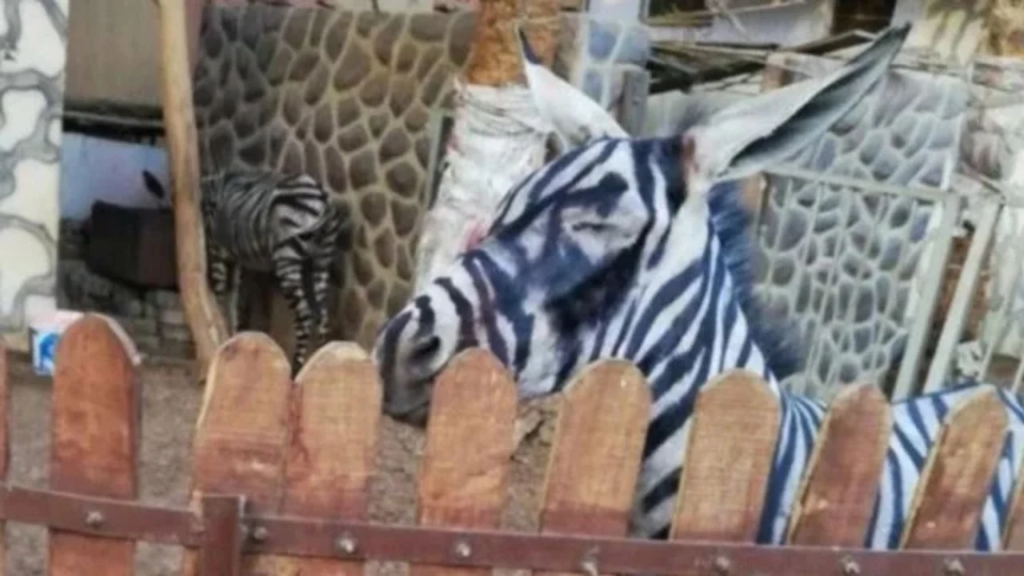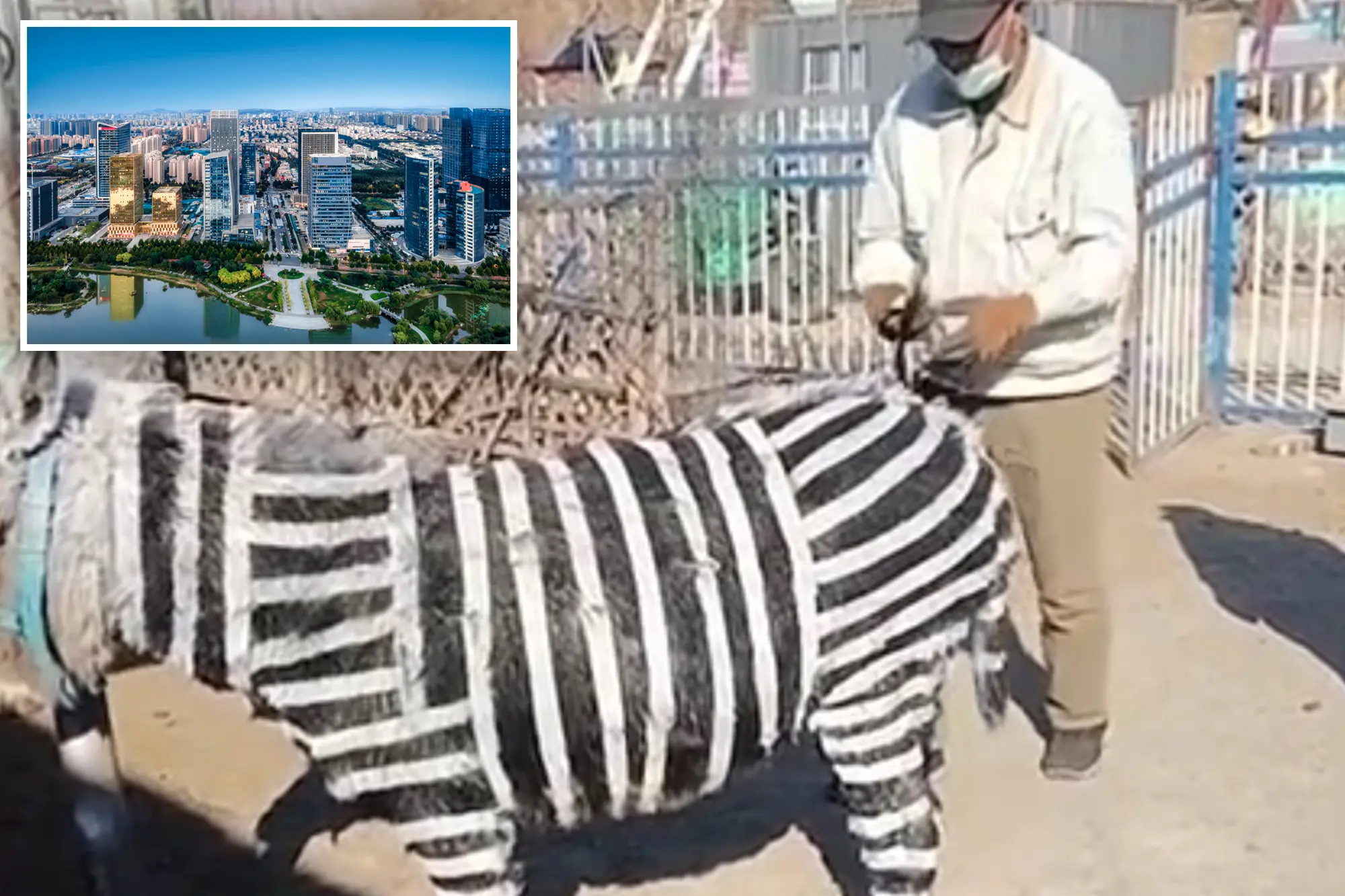A Chinese zoo in the Zibo City amusement park of Shandong province has come under scrutiny after it was revealed that they Painting Donkeys to Look Like Zebras.
The revelation has sparked widespread outrage on social media, with many users expressing their disapproval of the deceptive tactic. The zoo’s staff admitted that they used black and white dye on the donkeys, but insisted that the chemicals were non-toxic and safe for the animals.
However, this admission did little to quell public discontent, with many calling for stricter regulations on such unethical practices.
A Controversial Attempt to Attract Visitors
A photo circulating on social media showed a zoo worker standing beside a donkey that had been painted with zebra-like stripes. The animal’s unnatural appearance quickly caught the attention of netizens, who questioned the integrity of the zoo.
One staff member attempted to justify the act by stating that it was done “just for fun.” This justification was met with further criticism, as animal rights advocates argued that such actions trivialized the well-being of the animals.
This incident is not the first of its kind in China. A similar case occurred when a zoo dressed a dog as a panda to attract visitors. The pattern of using animals as promotional gimmicks has raised concerns over the ethical treatment of zoo animals and the lengths that some institutions will go to in order to boost attendance figures.
Read : Chinese Zoo Accused of Fattening Animals for Social Media Fame
Critics argue that misleading visitors not only damages the credibility of zoos but also sets a dangerous precedent for animal exploitation.
Social Media Outrage and Calls for Change
The revelation of the painted donkeys ignited a storm of criticism on Chinese social media platforms. Many users expressed their frustration over the lack of transparency and the disregard for animal welfare.
“It’s unfair to the animals and the visitors,” wrote one user, while another sarcastically questioned, “Why is it always China?” A third user criticized the poor execution of the paint job, pointing out that the donkeys still clearly looked like donkeys despite the attempt to disguise them.
Read : Outrage at Chinese Zoo for Painting Dogs to Look Like Pandas
The backlash has fueled discussions about the need for stricter regulations governing zoos and animal welfare in China. Experts and animal rights groups are calling for laws that would prohibit such deceptive practices and ensure that animals are treated with dignity and care.
While some zoos argue that such actions are harmless and merely serve as marketing strategies, critics argue that it fosters a culture of disrespect toward animals.

One of the primary concerns raised is the impact that such actions have on public trust. Visitors, particularly children, visit zoos expecting to learn about wildlife in an authentic setting.
When institutions resort to deception, it undermines their educational purpose and erodes public confidence. Ethical zoos focus on conservation and education, rather than misleading tactics to increase foot traffic.
Furthermore, the use of paint or dyes on animals, even if non-toxic, raises concerns about the potential stress and discomfort it may cause. Animal behavior experts argue that forcing animals to undergo unnatural changes for human entertainment can have negative psychological effects.
It also highlights the broader issue of how animals are often viewed as mere commodities rather than sentient beings deserving of respect and proper care.
A Recurring Pattern of Deception in Zoos
The painted donkeys incident is not an isolated event. Just a month prior, another Chinese zoo in Taizhou, Jiangsu Province, attempted to pass off Chow Chow dogs as tigers by dyeing their fur orange with black stripes.
The zoo even promoted the spectacle through a live broadcast on Douyin, the Chinese version of TikTok, claiming, “Our tigers are huge and very fierce!” However, social media users quickly pointed out that the animals in the wooden pens were clearly dogs, exposing the zoo’s deception.
When confronted, the Taizhou zoo admitted that the Chow Chow dogs had been dyed for promotional purposes but insisted that the dye was safe.
Despite their assurance, the stunt was met with widespread criticism and calls for tighter regulations on zoo practices. The incident highlighted the extent to which some zoos are willing to go to attract visitors, often at the expense of the animals’ dignity and well-being.

These repeated instances of misrepresentation in zoos point to a larger problem within the industry. Some zoos prioritize financial gain over ethical treatment and education, resorting to gimmicks that mislead the public.
The lack of stringent regulations and enforcement mechanisms allows such practices to continue unchecked. Unless significant changes are made, the cycle of deception is likely to persist.
Many animal welfare organizations are urging for reforms that would ensure zoos operate with transparency and adhere to ethical standards.
This includes better oversight, mandatory welfare checks, and penalties for institutions that engage in deceptive or harmful practices. Ethical zoos should focus on providing a safe and natural environment for animals while promoting genuine education and conservation efforts.
Ultimately, incidents like the painted donkeys and Chow Chow “tigers” serve as reminders of the need for stronger animal protection laws and greater accountability in the zoo industry.
While some may view these cases as humorous or harmless, they reflect a deeper issue of how animals are often exploited for commercial gain. For zoos to maintain their credibility and fulfill their role as educational institutions, they must prioritize the well-being of the animals in their care and operate with honesty and integrity.
let’s enjoy few years on earth with peace and happiness….✍🏼🙏

